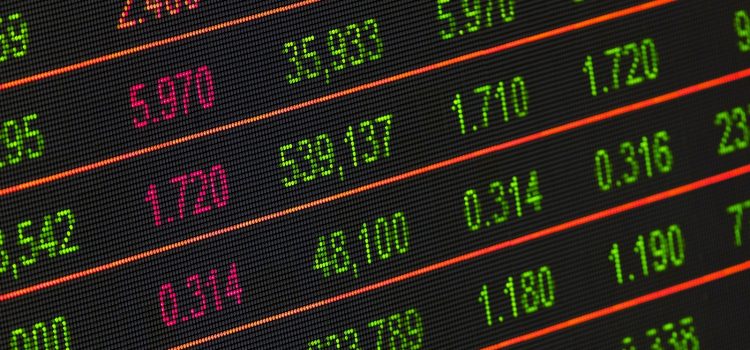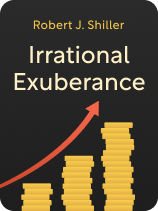

This article is an excerpt from the Shortform book guide to "Irrational Exuberance" by Robert J. Shiller. Shortform has the world's best summaries and analyses of books you should be reading.
Like this article? Sign up for a free trial here.
What are the key points in Irrational Exuberance, Robert J. Shiller’s book on speculative bubbles? What does Shiller teach about stock market behavior?
In Irrational Exuberance, Robert J. Shiller explains that speculative bubbles arise out of feedback loops, often driven by media coverage. When you learn more about these bubbles, you can better understand how to avoid losing money in stocks.
Continue reading for an overview of Irrational Exuberance.
Reading Irrational Exuberance
In Irrational Exuberance, Robert J. Shiller says mainstream economists’ faith in efficient markets is wildly misguided. Shiller argues that financial markets are rife with speculation, meaning that investors often drive prices far beyond their fair value. In Irrational Exuberance, Shiller contends that speculative bubbles pervade financial markets and outlines his theory of the structural, cultural, and psychological considerations that create and sustain these bubbles.
Irrational Exuberance was originally published in 2000 and focused mainly on the dotcom bubble of the 1990s. In 2005, Shiller published a second edition that contained additional discussions of the housing bubble that was growing at that time. Our overview is based on the book’s third edition, which was published in 2015 and includes Shiller’s analysis of the recent bond market.
As a co-recipient of the 2013 Nobel Prize in economics, along with Eugene Fama and Lars Peter Hansen, Shiller brings cutting-edge economic theory into his discussion of efficient markets in Irrational Exuberance. Moreover, as the author of other public-facing bestsellers like Narrative Economics and Finance and the Good Society, Shiller’s expertise distilling dense economic theory into accessible prose is evident throughout Irrational Exuberance.
Speculative Bubbles in Investing Markets
To understand Shiller’s account of speculative bubbles, we need to understand what these bubbles are in the first place. Shiller explains that speculative bubbles arise whenever news about an asset’s price increase generates further price increases as investors learn about the initial increase and become overly optimistic. These subsequent increases are a byproduct of investors’ zeal about previous increases rather than a result of concrete information about the asset’s true value.
Speculation in the US Stock Market
To show how speculative bubbles affect stock markets, Schiller examines the dotcom boom in the late 1990s, during which sharp increases in stock prices outstripped companies’ economic gains and price-earnings ratios soared to record highs.
As Shiller relates, the dotcom boom was the culmination of 18 years of unprecedented growth in the US stock market between July 1982 and August 2000. He points out that, between these dates, the US stock market increased 7.7-fold when adjusted for inflation. Moreover, between 1994 and 2000 alone, the stock market tripled in value. According to Shiller, this increase should have been accompanied by proportionate economic growth if it wasn’t the product of a speculative bubble. But no such growth occurred: Between 1994 and 2000, for example, US corporate profits increased only 60% and the gross domestic product (GDP) increased 40%, even though stock prices tripled in that same timeframe.
Speculation in the US Housing Market
Shiller notes that speculative bubbles aren’t restricted to the stock market. On the contrary, he writes that a speculative bubble drove the unprecedented growth in the US housing market between the late 1990s and 2006, as shown by sharp increases in housing prices that aren’t explained by underlying economic factors.
Speculative Bubbles and the Efficient Market Hypothesis
Although Shiller alleges that speculative bubbles affect numerous investing markets, many academics argue that such bubbles are actually impossible. These observers embrace the efficient market hypothesis (EMH)—the thesis that financial markets perfectly reflect all available information about securities (financial assets that you can buy and sell), meaning that securities are always accurately priced. For this reason, they maintain that speculative bubbles don’t exist because such bubbles would entail that securities are systemically mispriced.
Against this argument, Shiller argues that the EMH is flawed because in practice, the stock market is more volatile than we’d expect it to be if it were perfectly efficient. He points out that according to many economists, stocks’ dividends—the payments that companies distribute to shareholders—reflect companies’ intrinsic value (that is, their fair price) over the previous year. Thus, if the stock market were perfectly efficient, share prices should correspond neatly to future dividend prices, because these dividends reflect companies’ current intrinsic value. For example, in an efficient market, Tesla’s 2022 stock price should correspond with its dividends at the beginning of 2023, because these dividends reflect Tesla’s intrinsic value throughout 2022.
The Foundation of Speculative Bubbles
According to Shiller, speculative bubbles are made possible by feedback loops. He argues that feedback loops in investing markets reinforce the price changes caused by new financial information, leading to disproportionate price increases. To illustrate, he examines the dotcom boom of 2000.
How Feedback Loops Create Speculative Bubbles
Shiller writes that when relevant information drives a security’s price higher, that price increase itself often spurs further price increases, creating a feedback loop. These loops, he explains, can occur for various reasons. For example, if investors learn that Netflix’s stock has risen consistently over the past year, they might expect further increases going forward, leading them to purchase more Netflix stock and drive the price even higher.
As evidence that such feedback loops can occur, Shiller points to Ponzi schemes. He notes that these schemes initially rely upon a plausible (but specious) investment opportunity. For instance, ex-lawyer Scott Rothstein offered investors the opportunity to purchase shares of legal settlements, promising them a profitable return when he won the settlement. Then, the scheme’s perpetrator convinces a second round of people to invest, using these new funds to pay the first round of investors. Then, once people hear about the success of the initial investors, that leads to a third round of investors whose funds are used to pay the second round. And so on.
Case Study: The Factors Behind the Dotcom Boom
To determine which kinds of specific information can spark these feedback loops, Shiller examines the perceptions that set the stage for the dotcom boom. And although Shiller lists 12 such factors, we’ll focus on three key ones: the internet, the Baby Boom, and the creation of 401(k)s.
Factor #1: The Internet
Shiller points out that in the 1990s, investors expected the burgeoning internet to drive unprecedented economic growth. He notes that this narrative took root because impressive corporate earnings growth in 1994 through 1996 seemingly occurred in lockstep with the growth of the internet—though the internet actually had little to do with it, as internet companies were not yet turning large profits. But, because investors’ perceptions drive stock prices, rather than the reality itself, the internet’s perceived economic import spurred investors to purchase technology stocks.
Factor #2: The Baby Boom
Shiller argues that inflated economic expectations because of the Baby Boom (the US population surge following World War II) created heightened confidence that left the market ripe for speculation. He relates that several pervasive theories linked the Baby Boom with economic prosperity in the 1990s. For example, one theory held that Baby Boomers—who began preparing for retirement in the ’90s—would purchase stocks to fund their retirement accounts, leading to widespread stock market growth. Another theory held that Baby Boomers would invest aggressively because they hadn’t experienced the economic turmoil of the Great Depression, and that this investment would lead to price hikes.
Factor #3: The Beginning of 401(k)s
Finally, Shiller points out that in 1982, the first 401(k) plan was created, giving employees the chance to allocate some of their income to a retirement fund split between stocks and bonds. As 401(k)s became more popular, they increased employees’ exposure to the stock market, creating a new generation of would-be investors. Consequently, demand for stocks increased, providing further fuel for price increases.
The Growth of Speculative Bubbles
Although feedback loops often set the stage for speculative bubbles, Shiller contends that two cultural features sustain and strengthen these bubbles once they take root: media coverage of rising stock prices and economic theories that justify these prices.
How Media Coverage Furthers Speculative Bubbles
According to Shiller, when it comes to investing, the media doesn’t just passively present the news. He contends that the media actively contribute to investing highs and lows by drawing attention to price changes, which causes further price changes. To show as much, Shiller examines media coverage leading up to two key crashes in the US stock market: the 1929 crash and the 1987 crash.
Crash #1: Black Monday and Black Tuesday, October 1929
Black Monday and Black Tuesday refer to Monday October 28 and Tuesday October 29, 1929. During this two-day span, the Dow Jones dropped a total of 23% due to single-day drops of 12.8% and 11.7%—the two largest single-day drops in US history at the time. Normally, we would expect such drops to stem from concrete information impacting companies’ business fundamentals (the information that reflects a company’s financial health, such as its revenue and cash flow). But Shiller points out that media outlets reported no such information: The news was replete with mundane stories that had little to do with corporations’ fundamentals.
However, Shiller says, news outlets did report another story that could have influenced the stock market—namely, the temporary market drop of Black Thursday (October 24, 1929), in which the Dow was down 12% at one point but recovered by the day’s end. Shiller notes that on Sunday evening and the morning of Black Monday, prominent news outlets ran stories highlighting the tenuous nature of the market in the wake of Black Thursday. According to Shiller, this suggests that Black Monday and Tuesday didn’t result from news about companies’ financial prospects, but rather from increased awareness of market volatility. By making the stock market’s volatility salient, the media caused a chain reaction of price decreases on Black Monday and Tuesday.
Crash #2: Black Monday, October 1987
In a similar vein, Shiller discusses the next Black Monday, on October 19, 1987, in which the Dow Jones dropped nearly 23% in a single day—doubling the single-day drops of 1929. As an economist at Yale at the time, Shiller took advantage of this crash by surveying professional and amateur investors the week after the crash to collect their thoughts on the day of the crash. His surveys asked investors to rate the importance of different news stories from October 19 in their assessment of the stock market crash. As Shiller relates, these investors overwhelmingly responded that stories about the Dow’s morning decline—when it dropped around 7%—were the most important for their market evaluation.
Shiller reasons that although the Dow’s initial fall in the morning may have had something to do with business fundamentals, its subsequent decrease that day was largely driven by news of the initial decrease. He notes that this conclusion was shared by the Reagan administration’s Brady Commission—a group assigned with uncovering the causes of the crash—who found that while initial news reports about unfavorable tax legislation for corporations spurred the initial price drop, further news reports about the price drop itself encouraged further selling, leading to a calamitous crash.
How New-Era Economic Theories Further Speculative Bubbles
In addition to pervasive media coverage, Shiller points to a cultural tendency to justify market growth in terms of “new era” economic theories—theories that claim we’ve entered into a new economic era, meaning such growth will continue indefinitely. According to Shiller, new-era thinking further inflates speculative bubbles by causing investors to believe market growth is inevitable. And while Shiller examines new-era thinking during several eras of market booms, we’ll focus on two in particular: the 1920s and the 1950s.
Era #1: New-Era Thinking in the 1920s
During the bull market of the 1920s, several factors conspired to create a widespread belief that the US had entered a new economic era. As Shiller relates, the ’20s witnessed a technological explosion that was evident not just to the wealthy, but to the working class as well—automobiles became commonplace by the decade’s end, and electricity became standard even in rural areas that had previously relied on kerosene lamps. Further, the sharp increase in radio availability created a population that felt more interconnected than ever before.
Era #2: New-Era Thinking in the 1950s
Similarly, Shiller contends that the mid-1950s, which saw a 94% inflation-adjusted stock market rise between 1953 and 1955, was rife with new-era thinking that stemmed from several factors. First, as Shiller notes, the apparent peace in the wake of World War II gave rise to extreme optimism. Moreover, he points out that the sudden introduction of television instilled a vision of imminent technological innovation into Americans’ minds. Finally, because inflation had remained extremely low in the mid-’50s, many Americans believed the dollar would remain the strongest currency in the world.
The Limits of Speculative Bubbles
While media coverage and new-era thinking can strengthen speculative bubbles, Shiller maintains that psychological factors determine the extent to which these bubbles will grow. In particular, he argues that two types of psychological anchors—quantitative and moral—prevent speculative bubbles from growing indefinitely.
Quantitative Anchors
Shiller explains that quantitative anchors cause investors to keep stock prices relatively stable on a day-to-day basis. To illustrate the concept of quantitative anchors, he points to an experiment by Daniel Kahneman and Amos Tversky, in which they asked participants a question with an answer between 1 and 100 while displaying a wheel of fortune that landed on a random number between 1 and 100. Participants’ answers, they found, were heavily influenced by the wheel’s number—for instance, if participants were asked “What percentage of Americans earn above $50k annually?”, their answers were significantly higher if the wheel landed on 85 than if it landed on 35. The number before them thus anchored their response.
Moral Anchors
In a similar vein, Shiller contends that moral anchors determine how far a speculative bubble can grow before bursting. Moral anchors, he explains, refer to the narratives and reasons that convince investors to keep their money invested in the stock market rather than selling their stocks and cashing out. When a moral anchor is weak, investors will be more likely to sell their stocks and earn a tangible profit, causing a bubble to burst when this selling is widespread. By contrast, when a moral anchor is strong, investors will be more likely to hold their stocks and thus perpetuate speculative bubbles.
Shiller’s Advice for Financial Leaders and the Public
Although there’s no foolproof way to prevent speculative bubbles from taking root, Shiller maintains that financial leaders and the public can take steps to limit speculation. He argues that financial leaders should speak openly when they think the market is overpriced, and the public should diversify their portfolios to prevent prices in certain markets from rising irrationally.
Exercise: Assess Speculation in Different Asset Classes
Shiller suggests that speculation has influenced pricing in several different asset classes, namely stocks, bonds, and housing. In this exercise, evaluate Shiller’s arguments and reflect on speculative bubbles in your own country.
- Of the three asset classes that Shiller discusses (stocks, bonds, and housing), which do you think is most clearly susceptible to speculation at the moment? Why?
- Of these same asset classes, which do you think is least susceptible to speculation? Why?
- To what extent are you worried about speculative bubbles in your own country’s financial markets? Explain your answer.

———End of Preview———
Like what you just read? Read the rest of the world's best book summary and analysis of Robert J. Shiller's "Irrational Exuberance" at Shortform.
Here's what you'll find in our full Irrational Exuberance summary:
- That financial markets are rife with speculation
- The three key US financial markets where speculative bubbles have formed
- Recommendations to financial leaders and the public for mitigating bubbles






